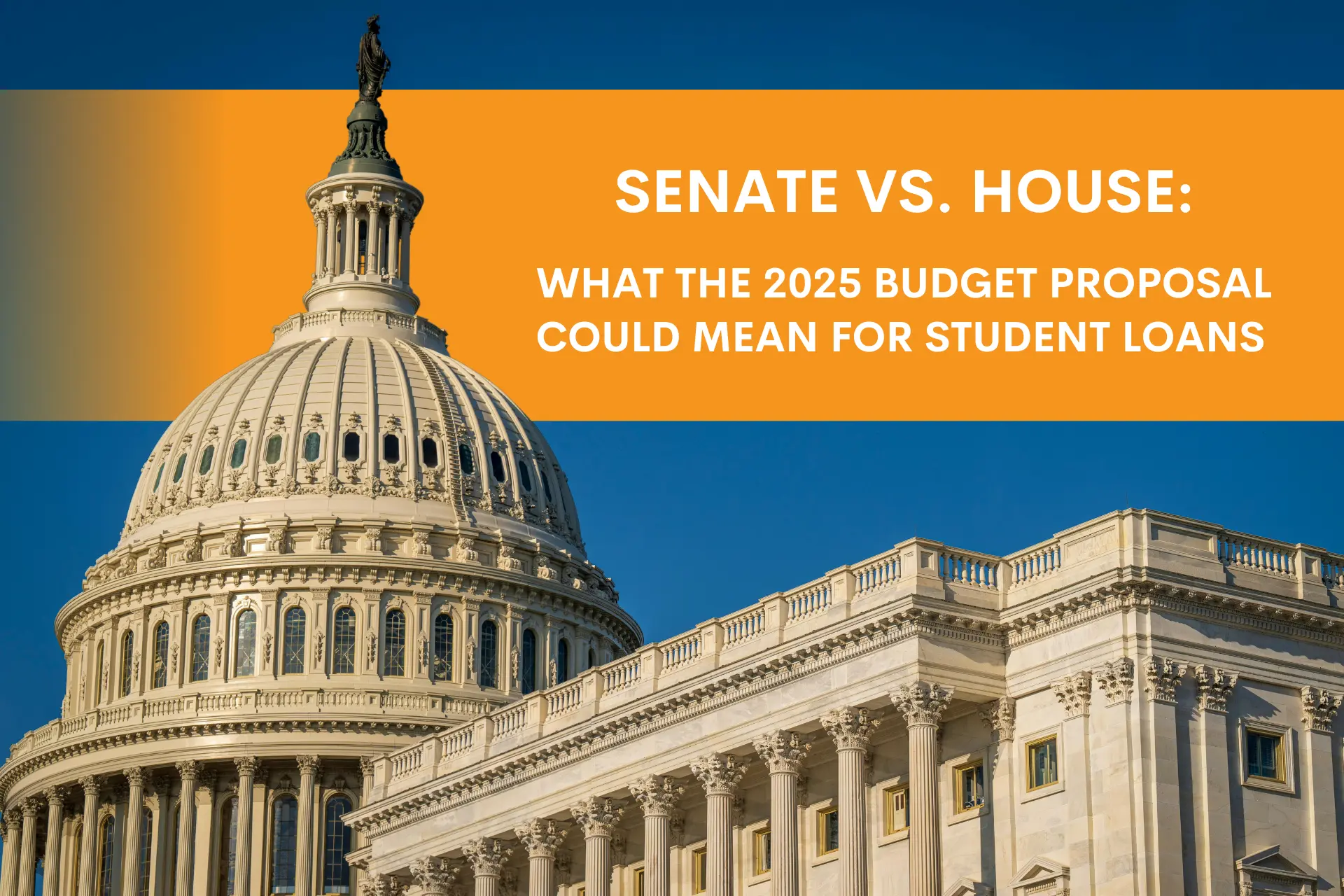Senate vs. House 2025 Budget Proposal
As Congress works to reconcile the sweeping budget proposals, student loan borrowers across the country face significant uncertainty. Both the House and Senate versions of the 2025 GOP budget propose deep reforms to the federal student loan system. And the specifics matter whether you’re a current borrower or planning to take out loans in the next year or two.
Where Things Stand: Senate Budget in Progress
The Senate’s version of the proposal, unveiled by the Health, Education, Labor and Pensions (HELP) Committee, is part of a larger package dubbed the “One Big Beautiful Bill Act”. This reconciliation bill combines education, tax, and immigration priorities. It’s being advanced under budget reconciliation rules, which means it could pass with a simple majority vote.
The Senate plan aims to reduce federal higher education spending by roughly $300 billion, with the bulk of those cuts targeting student loans and Pell Grants. It’s similar in intent to the House bill, but it takes a less aggressive approach in several key areas that will directly impact borrowers and educational institutions.
Key Differences Between House and Senate Proposals
Below is a side-by-side summary of how the two proposals diverge on critical elements of student loan policy:
Loan Limits
| Loan Type | House | Senate |
| Subsidized Loans | Eliminated | Preserved |
| Undergraduate Loans | $50K lifetime cap | No aggregate cap; capped annually by program cost |
| Graduate Loans | $100K lifetime cap | $100K lifetime; $20.5K annual |
| Professional Programs | $150K lifetime | $200K lifetime; $50K annual |
| Parent PLUS | $50K per parent total | $20K per student/year; $65K lifetime per student |
Translation: If you’re an undergrad, the Senate plan gives you more flexibility. If you’re a grad or professional student (or a parent of a student) your borrowing options are more tightly controlled under both versions, but the Senate’s are slightly more generous.
Repayment Plans
Both proposals would consolidate current repayment options into two:
Standard Plan: A tiered structure based on loan balance.
| Feature | House | Senate | ||
| Payment Terms | Loan Balance | Term | Loan Balance | Term |
| $0-$24,999 | 10 yrs | $0-$24,999 | 10 Yrs | |
| $25,000-$49,999 | 15 yrs | $25,000-$49,999 | 15 yrs | |
| $50,000-$99,999 | 20 yrs | $50,000-$99,999 | 20 yrs | |
| $100,000+ | 25 yrs | $100,000+ | 25 yrs |
RAP (Repayment Assistance Plan): An income-driven plan to replace all existing plans. No longer considering poverty level guidelines, the RAP plan would calculate payment directly from a borrower’s AGI.
| Feature | House | Senate |
| Payment Calculation |
Annual payment is 1% of AGI for every $10k in Federal debt. Max payment is 10%. Monthly payment is the annual payment divided by 12 and recalculated annually. |
Annual payment is 1% of AGI for every $10k in Federal debt. Max payment is 10%. Monthly payment is the annual payment divided by 12 and recalculated annually. |
| Spousal Income | Can be excluded from calculation if married filing separately | Spousal income will be included in payment calculation regardless of tax filing status |
| Minimum RAP Payment | $10/ month | $10/ month |
| Failure to Recertify | Not specified | Reverts to 10-year standard repayment |
| Interest Subsidy | If/when payment does not cover all monthly interest, 100% of remaining interest is subsidized. | If/when payment does not cover all monthly interest, 100% of remaining interest is subsidized. |
| Principal Reduction | All monthly payments will result in a reduction of principal of at least $50. | All monthly payments will result in a reduction of principal of at least $50. |
Translation: The Senate version is more rigid about spousal income, making it harder for married borrowers to reduce their monthly payments. It also comes with stricter enforcement if you miss paperwork deadlines.
Special Considerations for medical and dental residents: Both versions of the bill state that residents may no longer achieve credit for Public Service Loan Forgiveness during training. The House version allows up to four years of interest-free forbearance during training.
Special Considerations for Parent Plus Borrowers: The Senate version of the bill aims to put all Parent Plus borrowers (including consolidation loans used to pay off Parent Plus loans) into the new standard repayment plan referenced above. One exception to this new rule would be for borrowers (parents) who are already enrolled in an IDR plan before the new rules go into effect. If the forecasted payments under that standard plan are more than you can (or want to) pay, you could enroll in the ICR plan for now. Once the new repayment plans go live you would be switched over to the modified IBR plan.
It may be best to let the House and Senate reconcile their bills before taking this step, as the House Bill does not impose these repayment restrictions on Parent Plus loans.
| Category | House | Senate |
| Risk-Sharing | Yes – Colleges repay unpaid loan amounts | No – Programs lose eligibility if grad earnings too low |
| Pell Grant Changes | Cuts access for part-time students; tightens eligibility | Reduces funding only if scholarships cover full costs |
| Veteran Protections | Eliminated | Preserved |
Translation: The Senate is gentler on colleges and offers broader access to Pell Grants and veteran protections compared to the House version.
Bottom Line: What This Means for Borrowers
The Senate’s proposal is less severe than the House’s in several respects. It:
- Preserves subsidized loans and existing Pell Grant eligibility for most students
- Maintains slightly more borrowing power for professional students and parents
- Offers a more structured, though stricter, income-driven repayment system
- Imposes tougher recertification and tax filing rules for IDR borrowers
However, both plans eliminate Grad PLUS loans, tighten loan caps, and remove many deferment options (like economic hardship and unemployment deferments). Plus, the Senate version notably eliminates the ability to file taxes separately to reduce loan payments, a change that could significantly affect married borrowers.
What Happens Next?
The differences between the two chambers must be resolved in committee before any final version becomes law. Given the GOP’s narrow margins in both the House and Senate, and the sweeping nature of these reforms, negotiations could take time. But if either version passes, borrowers with loans disbursed after July 1, 2026, could face a very different repayment landscape.
If you’re still in school or planning to borrow in the next year, this is a critical moment to stay informed and proactive.
June 26th, 2025 Update:
“The Big, Beautify Bill” hit a roadblock in the Senate yesterday. The Senate Parliamentarian flagged several sections of for violating the Byrd Rule—meaning they’d require 60 votes to pass, not a simple majority.
These are the flagged items most relevant to student loan borrowers:
- Forcing new borrowers into the new repayment plans.
- Not letting residents accrue PSLF during training.
- Limiting the Secretary of Education’s power to issue regulations which are “economically significant”.
- Limiting student loans for certain non-citizen groups.
- Repealing Biden-era borrower defense rules
While Republicans could simply ignore these flags and proceed as planned, that would be considered a nuclear option. Instead, they are likely to remove these provisions or rework the language as it pertains to current borrowers.
A point of clarity: Republicans can still use the bill to change loan limits, restrict payment plans, and exclude residents from PSLF. They just won’t be able ot apply those new provisions to existing borrowers. We’ll have to wait and see what their next move is.
Questions? We’re Here to Help.
Student Loan Professor will continue to monitor these developments and break down what they mean for your specific situation. If you’re not sure how these proposals could affect your loans, or your financial future, reach out. We’re help you cut through the noise and find the plan that fits your lifestyle.
Brandon Barfield is the President and Co-Founder of Student Loan Professor, and is nationally known as student loan expert for graduate health professions. Since 2011, Brandon has given hundreds of loan repayment presentations for schools, hospitals, and medical conferences across the country. With his diverse background in financial aid, financial planning and student loan advisory, Brandon has a broad understanding of the intricacies surrounding student loans, loan repayment strategies, and how they should be considered when graduates make other financial decisions.





